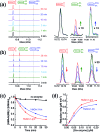Glutaredoxins employ parallel monothiol-dithiol mechanisms to catalyze thiol-disulfide exchanges with protein disulfides
- PMID: 29675162
- PMCID: PMC5885593
- DOI: 10.1039/c7sc04416j
Glutaredoxins employ parallel monothiol-dithiol mechanisms to catalyze thiol-disulfide exchanges with protein disulfides
Abstract
Glutaredoxins (Grxs) are a family of glutathione (GSH)-dependent thiol-disulfide oxidoreductases. They feature GSH-binding sites that directly connect the reversible redox chemistry of protein thiols to the abundant cellular nonprotein thiol pool GSSG/GSH. This work studied the pathways for oxidation of protein dithiols P(SH)2 and reduction of protein disulfides P(SS) catalyzed by Homo sapiens HsGrx1 and Escherichia coli EcGrx1. The metal-binding domain HMA4n(SH)2 was chosen as substrate as it contains a solvent-exposed CysCys motif. Quenching of the reactions with excess iodoacetamide followed by protein speciation analysis via ESI-MS allowed interception and characterization of both substrate and enzyme intermediates. The enzymes shuttle between three catalytically-competent forms (Grx(SH)(S-), Grx(SH)(SSG) and Grx(SS)) and employ conserved parallel monothiol and dithiol mechanisms. Experiments with dithiol and monothiol versions of both Grx enzymes demonstrate which monothiol (plus GSSG or GSH) or dithiol pathways dominate a specific oxidation or reduction reaction. Grxs are shown to be a class of versatile enzymes with diverse catalytic functions that are driven by specific interactions with GSSG/GSH.
Figures









Similar articles
-
Reduction potentials of protein disulfides and catalysis of glutathionylation and deglutathionylation by glutaredoxin enzymes.Biochem J. 2017 Nov 9;474(22):3799-3815. doi: 10.1042/BCJ20170589. Biochem J. 2017. PMID: 28963348
-
Glutaredoxin accelerates glutathione-dependent folding of reduced ribonuclease A together with protein disulfide-isomerase.J Biol Chem. 1995 Apr 7;270(14):7822-8. doi: 10.1074/jbc.270.14.7822. J Biol Chem. 1995. PMID: 7713872
-
One cysteine is enough: A monothiol Grx can functionally replace all cytosolic Trx and dithiol Grx.Redox Biol. 2020 Sep;36:101598. doi: 10.1016/j.redox.2020.101598. Epub 2020 May 31. Redox Biol. 2020. PMID: 32521506 Free PMC article.
-
Glutaredoxins in thiol/disulfide exchange.Antioxid Redox Signal. 2013 May 1;18(13):1654-65. doi: 10.1089/ars.2012.5007. Epub 2012 Dec 21. Antioxid Redox Signal. 2013. PMID: 23231445 Review.
-
Mono- and dithiol glutaredoxins in the trypanothione-based redox metabolism of pathogenic trypanosomes.Antioxid Redox Signal. 2013 Sep 1;19(7):708-22. doi: 10.1089/ars.2012.4932. Epub 2012 Oct 25. Antioxid Redox Signal. 2013. PMID: 22978520 Free PMC article. Review.
Cited by
-
Glutathione-Related Enzymes and Proteins: A Review.Molecules. 2023 Feb 2;28(3):1447. doi: 10.3390/molecules28031447. Molecules. 2023. PMID: 36771108 Free PMC article. Review.
-
Glutathione and Glutaredoxin-Key Players in Cellular Redox Homeostasis and Signaling.Antioxidants (Basel). 2023 Aug 3;12(8):1553. doi: 10.3390/antiox12081553. Antioxidants (Basel). 2023. PMID: 37627548 Free PMC article. Review.
-
Redox-inactive CC-type glutaredoxins interfere with TGA transcription factor-dependent repression of target promoters in roots.Plant Cell. 2025 Mar 5;37(3):koaf038. doi: 10.1093/plcell/koaf038. Plant Cell. 2025. PMID: 40053521 Free PMC article.
-
A glutaredoxin domain fused to the radical-generating subunit of ribonucleotide reductase (RNR) functions as an efficient RNR reductant.J Biol Chem. 2018 Oct 12;293(41):15889-15900. doi: 10.1074/jbc.RA118.004991. Epub 2018 Aug 30. J Biol Chem. 2018. PMID: 30166338 Free PMC article.
-
Can thiol-based redox systems be utilized as parts for synthetic biology applications?Redox Rep. 2021 Dec;26(1):147-159. doi: 10.1080/13510002.2021.1966183. Redox Rep. 2021. PMID: 34378494 Free PMC article.
References
LinkOut - more resources
Full Text Sources
Other Literature Sources
Molecular Biology Databases

